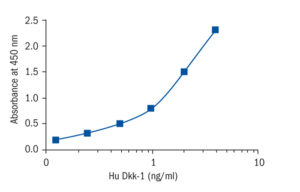Dickkopf-Related Protein 1 Human ELISA
Dickkopf-1 (Dkk-1) is encoded by the gene dickkopf together with other members of dickkopf protein family in vertebrates, Dkk-2, –3, –4 and a distant family member soggy, sometimes also called Dickkopf-like protein 1 (DKKL1). Dickkopf name is derived from german dick=thick and kopf=head and this protein was independently found and characterised and named as „Sk“. Dkk-1/Sk is composed from 266 amino acids and has predicted molecular weight 25.8kDa. The protein has one N-glycosylation site at the N-terminus. Dkk proteins possess the signal sequence and have two typical cysteine rich domains. The second cysteine-rich domain is required for binding to Lrp6 and Kremen-2. Up to now known receptors are from the family Lrp (Lrp5/6) and Kremen 1 and 2. Dkks are modulating Wnt signalling. Their effect is mostly inhibitory with exception of the Dkk-2 which is activating Wnt-signalling. Wnt signalling pathways are shifting the cell proliferation, cell identity and cell polarity from embryonic to adult homeostasis. Wnt is forming the complex composed of seven-transmembrane receptor Frizzled (Fz) receptor and a lipoprotein-receptor related protein Lrp5 or Lrp6. This triple complex formation is stabilizing the beta-catenin and activating the pathway. Dkk-1 is inhibiting this process by its interaction with Lrp6 that is blocking the Wnt-Fz-Lrp complex formation. The Lrp6-Dkk-1 is entering the cell by endocytosis allowed by the coreceptor Kremen. Dkk-1 in mouse was found to be exprimed in bone, specifically in osteoblasts and osteocytes. The overexpression of the Dkk-1 in Xenopus is causing the ectopic head formation and blocation by anti-Dkk-1 antibodies lead to microcephaly. In mouse models, when missing the Dkk-1, there was found incomplete development of structures anterior to the midbrain and consequently this lead to the perinatal death. In limb development of Dkk-1 null mice there has been found syndactyly and polydactyly. Dkk-1 ELISA is estimating the Dkk-1 in serum or plasma thus can be used in the cancer research, especially bone and lung cancer, as well as in the Paget’s disease or in the problems with bone calcification.
Features
- It is intended for research use only
- The total assay time is less than 3.5 hours
- The kit measures Dkk-1 in serum
- Assay format is 96 wells
- Quality Controls are human serum based
- Standard is recombinant protein based
- Components of the kit are provided ready to use, concentrated or lyophilized
Research topic
Bone and cartilage metabolism, Oncology
Type
Sandwich ELISA, Biotin-labelled antibody
Applications
Serum
Sample Requirements
50ul/well
Storage/Expiration
Store the complete kit at 2–8°C. Under these conditions, the kit is stable until the expiration date (see label on the box).
Calibration Curve

Calibration Range
0.125–4 ng/ml
Limit of Detection
0.032 ng/ml
Intra-assay (Within-Run)
n = 8; CV = 5.4%
Inter-assay (Run-to-Run)
n = 6; CV = 7.1%
Spiking Recovery
94,50%
Dilutation Linearity
93,20%
– Fouad YM, Mohamed HI, Kamal EM, Rasek MA. Clinical significance and diagnostic value of serum dickkopf-1 in patients with hepatocellular carcinoma. Scand J Gastroenterol. 2016 Sep;51 (9):1133-7
– Motovska Z, Vichova T, Tousek P, Dusek L, Widimsky P. Circulating osteoprotegerin and Dickkopf-1 changed significantly after surgical aortic valve replacement but remained without any significant differences after transcatheter aortic valve implantation. Int J Cardiol. 2012 Jul 12;158 (2):300-1

